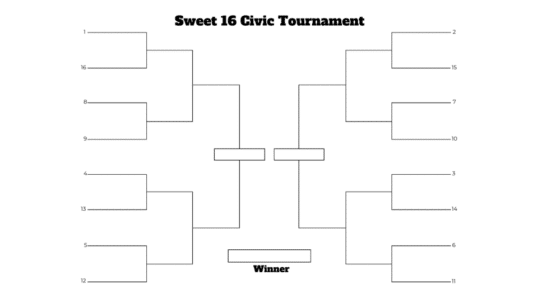Exploring the driving factors behind others’ choices
Dear collaborative discussion friends,
This week we are highlighting a fun activity that uses fictional characters or historical figures to help participants view an issue from very different perspectives. This activity encourages participants to understand how multiple factors influence a person’s choices in a given situation. It also provides participants with an option to explore how their own values, personalities, experiences and knowledge influence their own choices.
This activity is contributed by Ritu Thomas, Associate at the Interactivity Foundation, and is one of the many activities in the Culturally Responsive Collaboration Module.
If you missed the previous newsletter, Nurturing Intentional Empathy, you can access it and our other weekly newsletters by subscribing below.
This week’s activity:
Activity 4.9 – Taking the Perspective of Another
Using background information to understand another’s perspective and choices
This activity uses a combination of fun and serious topics to help participants practice viewing an issue from different perspectives. Participants use what they know about the characters presented, such as their values, personality traits, life experiences and knowledge, to decide what choice that person might make in a given situation. It also encourages them to explain their thought process and rationale for arriving at this decision.
Prepare for the Activity
For this activity, you will be using two characters or figures. You can pick two characters from a popular novel, movie, TV show, painting or photograph. You can also choose two historical figures or create your own characters.
If you are creating your own characters or picking figures that participants might not know much about, create a summary list of their values, traits, life experiences, knowledge, etc. to provide to participants at the beginning of the activity.
Depending on how much time you have, you can also invite participants to pick two fictional characters or historical figures themselves.
Make sure the two characters created or chosen are very different from each other.
Round 1: Choose a Fun Topic
Present a situation to the group where a decision needs to be made or some kind of action taken. For the first round of this activity, choose a fun topic, like where to go for vacation, what to buy as a present, or what to order on the menu.
Break into Small Groups & Decide on Choices
Have participants break into small groups (4-8 ppl) or pairs. Using the information provided or what they know or can deduce about the two characters, have participants:
- Discuss and decide what decision/choice each character would make in this situation
- Explain their rationale – what values, thoughts, feelings, experiences, and/or knowledge drive this choice?
Once each group/pair is finished, have them write the decision they came up with for each character on a whiteboard, shared screen, or other surface visible to the whole group.
Round 2: Choose a Serious Topic
Repeat the activity with a more serious topic. This time have the group decide how each character would respond to the following scenario:
“The city council is voting on a proposal to convert a plot of downtown parkland into an affordable housing development. The city has a severe shortage of affordable housing stock. This parkland is the only undeveloped land under the city’s control. The proponents on the city council see this conversion as a major way to make the city a more inclusive community, as it will counter the forces of gentrification that have been pricing many low-income residents out of the city. Opponents point to the need for greenspace for the physical and mental health for all city residents. And they highlight the fact that the existing parkland is the only green space that is readily accessible to existing low-income neighborhoods.”
Tip: You can also create your own scenario that is relevant to your group.
Break into Small Groups & Decide on Choices
Have participants return to their small groups or pairs and invite them to:
- Discuss and decide what decision/choice each character would make in this scenario
- Explain their rationale – what values, thoughts, feelings, experiences, and/or knowledge drive this choice?
Once again, have the groups record their responses on a shared surface.
Share Personal Choices
If time permits (and participants are open to sharing on a more personal level), ask them to now share with each other, in their small groups or pairs, how they would respond to this scenario (or another scenario). Invite participants to explore how their values, experiences, knowledge, etc. inform their decisions. If the group is in agreement, ask them to imagine the person who would make a different decision. Imagine how they came to this decision using generous thinking (i.e. imagine the most generous case for making this decision).
Once again, record responses on a shared surface.
Debrief as a Full Group
Come back together as a full group and discuss:
- What similarities do you see between all the decisions listed for each character? Did many groups/pairs come up with similar decisions? If so, why do you think this is?
- What differences do you see? Did many groups/pairs come up with different decisions? If so, why do you think this is?
- Which of the decisions jump out as the most surprising or unique?
In addition to these debriefing questions, the full description of Activity 4.9 Taking the Perspective of Another includes reflection questions, a practice journal prompt, and additional resources to help participants dive deeper.
If you try out this activity, please share with us what you think:
We hope this toolkit activity helps participants practice perspective-taking and gain a deeper understanding of the various factors that influence their own and others’ views and choices in regards to a particular issue.
Upcoming Events
- The School of Public Affairs at American University is hosting an online conversation about dialogue and pedagogy, “Can We Talk? Defining, Practicing, and Protecting Dialogue in Higher Education” on June 13th and 14th from 1pm – 5pm (EDT). Over the two days, this event will have four 90-minute sessions, each beginning with a short keynote followed by an interactive facilitated discussion. All are welcome! Register here.
- We are also accepting nominations for our Pilot Coach Training for Undergraduate Students which will take place this fall. Space will be limited. You can learn more or nominate a student by emailing Shannon at [email protected]
Looking forward to collaborating,
Ritu Thomas & the Collaborative Discussion Team





